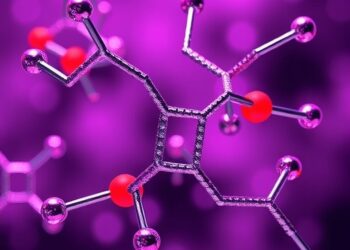Dinosaurs continue to fascinate people, but that’s not their only enduring quality: Collagen in their skeletons remains intact for millions of years, despite containing chemical bonds that should only persist for about 500 years. Now, scientists report in ACS Central Science that the unique tenacity of this protein may result from a molecular structure that shields these vulnerable bonds from attack by water that’s present in the environment.
Dinosaurs continue to fascinate people, but that’s not their only enduring quality: Collagen in their skeletons remains intact for millions of years, despite containing chemical bonds that should only persist for about 500 years. Now, scientists report in ACS Central Science that the unique tenacity of this protein may result from a molecular structure that shields these vulnerable bonds from attack by water that’s present in the environment.
Collagen is the most abundant protein in animals. It’s found in skin and connective tissues, such as cartilage and bones. Fragments of collagen have been extracted from the bones of 68-million-year-old fossils of Tyrannosaurus rex and may have even been detected in the skeleton of a 195-million-year-old Lufengosaurus. Collagen consists of protein strands — chains of amino acids — that form triple helices. Much like a rope, the helices in turn weave together to form a strong fibrous material. When exposed to water, the peptide bonds that connect amino acids normally break down in a process known as hydrolysis. But when peptides are incorporated in collagen, that destructive process doesn’t take place. Various explanations have been proposed, but Ron Raines and colleagues felt those theories were missing a physical and chemical basis for the resistance of peptide bonds in collagen like that preserved in ancient dinosaur bones. The team set out to fill in the missing links.
Using experimental and computational methods, the researchers examined the behavior of small-molecule mimics of collagen peptides. In particular, they studied the interactions between the molecules’ acyl groups, which each contain a carbon atom double bonded to an oxygen atom. They found that each acyl group partially shares its electrons with a neighboring acyl group. These results suggest that such interactions protect every peptide bond in a collagen triple helix from hydrolysis, and therefore the structure is able to stay intact. The researchers say lessons from the stability conferred by these interactions could help guide the design of other exceptionally long-lived materials.
The authors acknowledge funding from the National Institutes of Health.
The paper’s abstract will be available on Sept. 4 at 8 a.m. Eastern time here:
###
The American Chemical Society (ACS) is a nonprofit organization chartered by the U.S. Congress. ACS’ mission is to advance the broader chemistry enterprise and its practitioners for the benefit of Earth and all its people. The Society is a global leader in promoting excellence in science education and providing access to chemistry-related information and research through its multiple research solutions, peer-reviewed journals, scientific conferences, eBooks and weekly news periodical Chemical & Engineering News. ACS journals are among the most cited, most trusted and most read within the scientific literature; however, ACS itself does not conduct chemical research. As a leader in scientific information solutions, its CAS division partners with global innovators to accelerate breakthroughs by curating, connecting and analyzing the world’s scientific knowledge. ACS’ main offices are in Washington, D.C., and Columbus, Ohio.
Registered journalists can subscribe to the ACS journalist news portal on EurekAlert! to access embargoed and public science press releases. For media inquiries, contact newsroom@acs.org.
Note: ACS does not conduct research, but publishes and publicizes peer-reviewed scientific studies.
Follow us: X, formerly Twitter | Facebook | LinkedIn | Instagram
Journal
ACS Central Science
Article Title
Pauli Exclusion by n→π* Interactions: Implications for Paleobiology
Article Publication Date
4-Sep-2024




